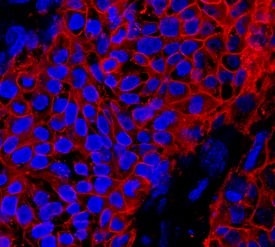Human Alkaline Phosphatase/ALPL Antibody
R&D Systems, part of Bio-Techne | Catalog # MAB29091

Key Product Details
Species Reactivity
Validated:
Cited:
Applications
Validated:
Cited:
Label
Antibody Source
Product Specifications
Immunogen
Leu18-Ser502
Accession # P05186
Specificity
Clonality
Host
Isotype
Scientific Data Images for Human Alkaline Phosphatase/ALPL Antibody
Alkaline Phosphatase/ALPL in BG01V Human Embryonic Stem Cells.
Alkaline Phosphatase/ALPL was detected in immersion fixed BG01V human embryonic stem cells using Rat Anti-Human Alkaline Phosphatase/ALPL Monoclonal Antibody (Catalog # MAB29091) at 10 µg/mL for 3 hours at room temperature. Cells were stained using the NorthernLights™ 557-conjugated Anti-Rat IgG Secondary Antibody (red; Catalog # NL013) and counterstained with DAPI (blue). Specific staining was localized to cell surfaces. View our protocol for Fluorescent ICC Staining of Cells on Coverslips.Applications for Human Alkaline Phosphatase/ALPL Antibody
Immunocytochemistry
Sample: Immersion fixed BG01V human embryonic stem cells
Reviewed Applications
Read 3 reviews rated 5 using MAB29091 in the following applications:
Formulation, Preparation, and Storage
Purification
Reconstitution
Formulation
Shipping
Stability & Storage
- 12 months from date of receipt, -20 to -70 °C as supplied.
- 1 month, 2 to 8 °C under sterile conditions after reconstitution.
- 6 months, -20 to -70 °C under sterile conditions after reconstitution.
Background: Alkaline Phosphatase/ALPL
Four distinct genes encode alkaline phosphatases (APs) in humans (1). The ALPL gene encodes the liver/bone/kidney isozyme, also known as the tissue-nonspecific AP (TNAP). In comparison, ALPI, ALPP and ALPPL2 encode intestinal, placental and placental-like or germ cell APs, respectively. The serum levels of human APs are useful tumor markers (2). There are many mutations in the ALPL gene, leading to different forms of hypophosphatasia, characterized by poorly mineralized cartilage and bones (3). The native ALPL is a glycosylated homodimer attached to the membrane through a GPI-anchor. The C-terminal pro peptide (residues 503‑524) is not present in the mature form.
References
- Le Du, M-H. and J.L. Millan (2002) J. Biol. Chem. 277:49808.
- Millan, J.L. and W.H. Fishman (1995) Crit. Rev. Clin. Lab. Sci. 32:1.
- Di Mauro, S. et al. (2002) J. Bone Miner. Res. 17:1383.
Long Name
Alternate Names
Gene Symbol
UniProt
Additional Alkaline Phosphatase/ALPL Products
Product Documents for Human Alkaline Phosphatase/ALPL Antibody
Product Specific Notices for Human Alkaline Phosphatase/ALPL Antibody
For research use only
